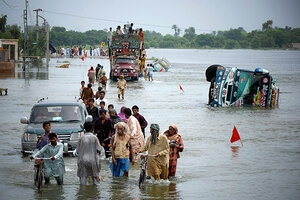One year after its worst flooding, is Pakistan ready for monsoon season?
Pakistan’s record floods last year killed some 2,000 people and displaced 20 million. Many officials say the country is still not properly prepared to deal with this year's imminent monsoon season.

In this Aug. 19, 2010 file photo, flood survivors negotiate a flooded road at Muzaffargarh, in central Pakistan. Almost one year later after its worst flooding, is Pakistan ready for monsoon season?
Khalid Tanveer/AP/File
Islamabad, Pakistan
Almost one year after the worst floods in its history, Pakistan's response to major flooding predicted for next month could be compromised by deep flaws in its disaster management response strategy, say current and former top officials.
Last year’s catastrophic floods covered almost a quarter of the country, killing some 2,000 people and affecting upward of 20 million. This year, rainfall is expected to be about 10 percent lower than in 2010, and authorities say 2- to 6 million people could be adversely affected.
But that's a best-case scenario. Factors ranging from limiting the powers of the National Disaster Management Authority (NDMA), to a failure to desilt dams, plant trees on heavily deforested land, and draw up new plans for flood zoning could mean a repeat of last year's widespread loss of life and property destruction, say multiple officials at the NDMA.
“The scenario is pretty grim. We haven’t done a lot since last year – the sanctioned strength of the NDMA has not been increased, in fact we’re still facing a severe shortfall,” says one senior official, saying a full staff of 21 officers had an annual budget of only some $740,000.
And then, there is the murky matter of politics.
The NDMA has been nominally empowered by a parliamentary bill to head up the full spectrum of Pakistan’s disaster response. But its authority has eroded due to the expanded role of the Earthquake Reconstruction & Rehabilitation Authority (ERRA) headed by lawmaker Hamid Yar Hiraj, whose political party was brought into the ruling coalition late last year in order to shore up the weak civilian government.
“When you give a clear cut responsibility to NDMA, which is the lead organization for disaster management, then you need to empower it, you need to support it. In our country, one of the issues is that even when you have legal mandate, you need the ownership of the highest level. And when that is missing, some of the institutions become redundant,” says Gen. Nadeem Ahmad, the former head of the NDMA who resigned two months ago over the political controversy.
Lack of clarity regarding what roles UN agencies should play during disaster also does not bode well for this year’s rainy season. The exact role of the NDMA, and the other provincial disaster management authorities (PDMAs), has yet to be resolved, adds Usman Qazi, early recovery adviser for the NDMA, particularly after an amendment to the Constitution devolved key decisionmaking powers to the provincial level.
Lack of coordination between disaster responders
An internal NDMA report obtained by the Monitor indicated that coordination between the government and 12 UN organizations suffered from a lack of coordination with local authorities last year, at times hampered by language difficulties.
A senior official also cites out-of-date breaching plans for the various dams along the River Indus as a danger. The plans were devised by the British in the 1920s.
As it works now, breaching the dam would mean flooding areas that are now populated by infrastructure such as gas fields, military cantonments, and chemical factories. “You are left between the devil and the deep sea. If you breach the right bank you drown populated districts,” he says.
Authorities are more confident about the ability of new early warning systems put in place following last year's disaster to alert and evacuate potential flood victims. But, says the senior official, the monitoring systems in place for Pakistan’s western rivers, including the Kabul River, which flows from Afghanistan, are not as widely covered as the rivers from India and China (the rivers that flooded in 2010).
What's global warming got to do with it?
While rains this year aren’t expected to be as heavy as last year’s, which saw 180 percent of normal monsoon rainfall in some areas, scientists predict giant flood events are more likely in the future, partly due to global warming.
“The north of Pakistan is a turmoil area due to wars and conflicts. The little vegetation left is rapidly being removed, which leads to more runoff and flooding. Higher temperatures will remove more carbon from soils and reduce vegetation as well,” says Ausaf Rahman, a geology and hydrology expert.
Historically, catastrophic floods in the Indus River Plain occur every 100 years, while major events occur every 20 years or so, says Peter Clift, a professor at Department of Geology and Petroleum Geology at the University of Aberdeen, who has spent time researching core sediments that indicate when sediment from the floods have run-off to the ocean in the port city of Karachi.
“As a good rule of thumb, we associate strong monsoons with global warming. Not necessarily every year but many years,” says Dr. Clift, though he adds the strength of sun rays reaching the planet – the same processes that drive shrinking and growing of ice sheets – also affect the intensity of the monsoon in the long-term. Short-term variation, he says, occurs due to the jet stream and the strength of the El Niño.
Staff writer Ben Arnoldy contributed to this report.
